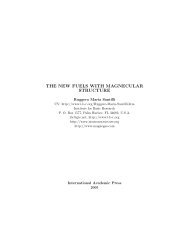hadronic mathematics, mechanics and chemistry - Institute for Basic ...
hadronic mathematics, mechanics and chemistry - Institute for Basic ...
hadronic mathematics, mechanics and chemistry - Institute for Basic ...
You also want an ePaper? Increase the reach of your titles
YUMPU automatically turns print PDFs into web optimized ePapers that Google loves.
HADRONIC MATHEMATICS, MECHANICS AND CHEMISTRY 31<br />
<strong>for</strong> the unspoken, but transparent <strong>and</strong> pre-meditated intent of maintaining the<br />
dominance of Einsteinian doctrines in physics.<br />
At any rate, experimental data are elaborated via the conventional scattering<br />
theory that, even though impeccable <strong>for</strong> electromagnetic interactions among pointlike<br />
particles, is fundamentally insufficient <strong>for</strong> a serious representation of the<br />
scattering among extended, nonspherical <strong>and</strong> hyperdense hadrons (Figure 1.2 <strong>and</strong><br />
Chapter 3).<br />
As a matter of fact, serious scholars <strong>and</strong>, above all, future historians, should<br />
focus their main attention on the fact that the climax of unscientific conduct<br />
by organized interests on Einsteinian doctrines occurs primarily in the manipulation<br />
of experiments, beginning with the control of the conditions of funding,<br />
then following with the control of the conduction of the experiments <strong>and</strong>, finally,<br />
with the control of the theoretical elaboration of the data to make sure that the<br />
orchestrated compliance with Einsteinian doctrines occurs at all levels.<br />
Among an unreassuringly excessive number of cases existing in the literature,<br />
some of which are reviewed in Chapter 6, a representative case is that of the Bose-<br />
Einstein correlation in which protons <strong>and</strong> antiprotons collide at high energy by<br />
annihilating each other <strong>and</strong> <strong>for</strong>ming the so-called “fireball”, that, in turn, emits a<br />
large number of unstable particles whose final product is a number of correlated<br />
mesons (see, e.g., review [7] <strong>and</strong> Figure 1.7).<br />
The simplest possible case is that of the two-points correlation function<br />
C 2 = P (p 1, p 2 )<br />
P (p 1 ) × P (p 2 ) , (1.2.14)<br />
where p 1 <strong>and</strong> p 2 are the linear momenta of the two mesons <strong>and</strong> the P ’s represent<br />
their probabilities.<br />
By working out the calculations via unadulterated axioms of relativistic quantum<br />
<strong>mechanics</strong> one obtains expressions of the type<br />
C 2 = 1 + A × e −Q 12<br />
− B × e −Q 12<br />
, (1.2.15)<br />
where A <strong>and</strong> B are normalization parameters <strong>and</strong> Q 12 is the momentum transfer.<br />
This expression is dramatically far from representing experimental data, as shown<br />
in Chapter 5.<br />
To resolve the problem, supporters of the universal validity of quantum <strong>mechanics</strong><br />
<strong>and</strong> special relativity then introduce four arbitrary parameters of unknown<br />
physical origin <strong>and</strong> motivation called “chaoticity parameters” c µ , µ =<br />
1, 2, 3, 4, <strong>and</strong> exp<strong>and</strong> expression (1.2.15) into the <strong>for</strong>m<br />
C 2 = 1 + A × e −Q 12/c 1<br />
+ B × e −Q 12/c 2<br />
+ C × e −Q 12/c 3<br />
− D × e −Q 12/c 4<br />
, (1.2.16)<br />
which expression does indeed fit the experimental data, as we shall see. However,<br />
the claim that quantum <strong>mechanics</strong> <strong>and</strong> special relativity are exactly valid is a<br />
scientific deception particularly when proffered by experts.














